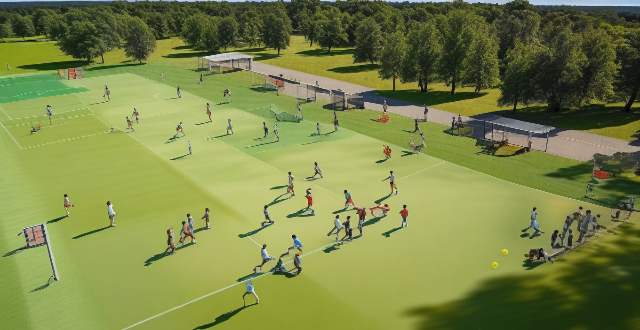Promote Leadership

How can we encourage more women to pursue leadership roles ?
Encouraging Women to Pursue Leadership Roles - **Education and Awareness**: Promote STEM education, highlight role models, address gender stereotypes. - **Workplace Policies and Practices**: Establish flexible work arrangements, provide mentorship programs, enforce anti-discrimination laws. - **Networking and Professional Development**: Sponsor women's networking events, offer leadership training programs, create women-specific scholarships. - **Cultural Change and Empowerment**: Promote a culture of inclusivity, address the confidence gap, celebrate women's achievements.

How do academic challenges, such as debate teams or science competitions, promote leadership skills in students ?
Academic challenges such as debate teams and science competitions promote leadership skills in students by fostering critical thinking, collaboration, innovation, problem-solving, self-confidence, time management, and interpersonal skills. These skills are essential for effective leadership and can help students succeed both academically and professionally.

How can schools effectively cultivate student leadership skills ?
Schools can cultivate student leadership skills by creating opportunities for leadership roles, encouraging teamwork and collaboration, providing training and workshops, fostering a culture of respect and inclusivity, and offering mentorship programs.

How has the #MeToo movement influenced perceptions of female leadership ?
The #MeToo movement has increased awareness of gender bias and prompted changes in corporate culture, leading to greater representation of women in leadership roles. However, challenges remain in achieving true gender equality.

How does female leadership differ from male leadership ?
Female and male leaders exhibit distinct characteristics in communication, decision-making, management styles, emotional intelligence, and negotiation tactics. Female leaders often prioritize collaboration, consensus, and empathy, while male leaders tend to be more directive, risk-prone, and competitive. Recognizing these differences can foster diverse leadership environments that value a range of perspectives and strengths.

How can education institutions foster climate leadership among students ?
Education institutions can foster climate leadership among students through curriculum integration, extracurricular activities, infrastructure improvements, collaboration and partnerships, and policy and leadership support. By adopting these strategies, they can contribute to global efforts in mitigating climate change.

How can companies support the development of female leadership talent ?
Companies can support the development of female leadership talent by implementing a variety of strategies and programs that address the unique challenges faced by women in the workplace. Here are some key ways to foster female leadership: 1. Create a diverse and inclusive culture 2. Provide mentoring and sponsorship opportunities 3. Offer professional development programs 4. Foster a collaborative work environment 5. Set clear goals and measure success

How does climate leadership differ from traditional forms of leadership ?
Climate leadership is a specialized form of leadership that focuses on addressing the challenges and complexities associated with climate change. It differs from traditional forms of leadership in several key ways, including its scope, urgency, collaborative nature, and long-term perspective. Climate leadership addresses global issues that affect the entire planet and all its inhabitants, while traditional leadership often focuses on organizational goals, profits, or specific projects. Climate leadership operates with a sense of urgency due to the accelerating pace of climate change, while traditional leadership may operate on a more relaxed timeline. Climate leadership emphasizes horizontal integration and networked governance structures, engaging with external stakeholders such as governments, NGOs, and international bodies. In contrast, traditional leadership typically operates within a hierarchical structure where decision-making is centralized. Climate leadership considers the long-term implications of decisions for future generations and prioritizes sustainable practices that balance economic growth with environmental stewardship. Traditional leadership tends to focus on quarterly results or annual performance targets and may prioritize short-term gains over long-term sustainability. Climate leadership encourages innovation and experimentation to find new solutions to complex problems and fosters a learning environment where failure is seen as an opportunity for growth. Traditional leadership may rely on established methods and processes and can be resistant to change if it disrupts current operations. Finally, climate leadership places ethical considerations at the forefront, acknowledging the moral imperative to act and recognizing the interconnectedness of environmental health with social equity and justice. In contrast, traditional leadership is often centered on legal compliance and shareholder value, with ethics being secondary to profitability and efficiency. In summary, climate leadership demands a broader vision, greater urgency, extensive collaboration, a long-term outlook, continual innovation, and a strong ethical foundation. It requires leaders who are not only skilled in their respective fields but also possess a deep understanding of environmental issues and the ability to inspire collective action towards a more sustainable future.

How does sports leadership differ from other types of leadership ?
Sports leadership is distinguished by its goal-oriented focus, clear team hierarchy, emotional intensity, physical component, short-term outcomes, public scrutiny, adaptability, and cultural impact. Unlike other types of leadership, sports leaders must manage high levels of emotion, direct physical performance, and adapt quickly to changing circumstances during a game. They also play a significant role in shaping the culture and values of their team, which can have a profound impact on the wider community.

What role does communication play in sports leadership ?
Communication is vital for sports leadership, helping achieveCommunication is vital for sports leadership, helping achievehesion, and foster a helping achieve success, build team cohesion, and foster a positive environment. Clear and concise messaging, active listening, encouragement, and motivation are key components of effective communication in sports leadership. Benefits of effective communication include increased performance, improved team cohesion, enhanced athlete development, and greater satisfaction and retention.

In what ways do women contribute uniquely to leadership roles in the workplace ?
Women's contributions to leadership roles in the workplace include empathy, emotional intelligence, inclusivity, collaborative leadership, adaptability, communication skills, and innovative thinking. These qualities can lead to more compassionate and diverse work environments, effective decision-making, and creative problem-solving.

How can sports leadership training programs benefit coaches and athletes ?
Sports leadership training programs can greatly benefit coaches and athletes by enhancing their skills and knowledge, leading to improved performance on and off the field. Coaches can improve communication, leadership qualities, motivation techniques, goal setting, and tactical knowledge, while athletes can develop self-confidence, teamwork skills, responsibility, time management, and mental toughness.

What is the influence of sports on leadership skills development among adolescents ?
This article discusses the influence of sports on leadership skills development among adolescents. It highlights the importance of leadership skills and how sports can contribute to their development through communication, problem-solving, decision-making, teamwork, and self-motivation. The article concludes that sports have a significant impact on the development of essential leadership qualities that are important for success in various aspects of life.

What are the benefits of fostering leadership in students from a young age ?
Fostering leadership in students from a young age has numerous benefits, including enhanced personal development, improved social skills, increased confidence, better academic performance, preparation for future roles, and a positive impact on society. Leadership training helps students develop valuable skills such as decision-making, problem-solving, time management, communication, collaboration, and empathy. These skills are beneficial in academic settings and personal lives, leading to well-liked and respected individuals. Taking on leadership roles also builds confidence and self-esteem, translating into other areas of life, including academic performance and future career prospects. Research shows that students with strong leadership qualities tend to perform better academically due to effective study habits, time management skills, and a strong work ethic. Fostering leadership prepares students for future roles in the workplace, community organizations, and political arenas, setting them up for success later in life. Developing strong leaders from a young age creates an engaged and active citizenry capable of addressing complex issues and working towards positive change.

How can sports help individuals develop leadership skills and personal growth ?
Participating in sports can help individuals develop leadership skills and foster personal growth by enhancing goal-setting, teamwork, resilience, decision-making under pressure, accountability, confidence building, discipline, physical health, emotional intelligence, and social interaction.

What is the impact of sports programs on the leadership development of students ?
Sports programs in educational institutions have a profound impact on the leadership development of students. These programs provide opportunities for students to develop essential leadership skills such as teamwork, communication, decision-making, and problem-solving. In this article, we will discuss the various ways in which sports programs contribute to the leadership development of students. One of the most significant benefits of participating in sports programs is the opportunity to work with others towards a common goal. This experience teaches students how to collaborate effectively, communicate clearly, and support their teammates. These skills are essential for successful leadership, as leaders must be able to work collaboratively with their team members to achieve their objectives. Participating in sports programs also helps students develop strong communication skills. Athletes must be able to communicate effectively with their coaches, teammates, and even opponents during competitions. This experience teaches students how to convey their thoughts and ideas clearly and persuasively, which is an essential skill for leaders. Sports programs also provide opportunities for students to develop decision-making and problem-solving skills. Athletes must make split-second decisions during games and matches, often under pressure. This experience teaches students how to analyze situations quickly and make informed decisions based on the available information. Finally, sports programs teach students how to set goals and work towards achieving them. Athletes must set personal and team goals, create plans to achieve them, and track their progress along the way. This experience teaches students how to set realistic goals, develop strategies to achieve them, and persevere through challenges. In conclusion, sports programs have a significant impact on the leadership development of students. By providing opportunities for teamwork, communication, decision-making, problem-solving, and goal setting, sports programs help students develop essential leadership skills that they can apply in other areas of their lives. As educators and parents, it is our responsibility to encourage our children to participate in sports programs and support their growth as leaders both on and off the field.

How do sports teach important life skills such as teamwork, perseverance, and leadership ?
The text discusses how sports teach important life skills, including teamwork, perseverance, and leadership. In sports, teamwork is crucial for success, requiring communication, cooperation, and understanding each other's strengths and weaknesses. Athletes learn to collaborate effectively with others, which can be applied in various aspects of life. Sports also teach perseverance by exposing athletes to challenges and setbacks, developing resilience and determination. Participating in sports provides opportunities for individuals to develop leadership skills, such as taking initiative, motivating teammates, and being responsible for the team's success or failure. These skills not only contribute to success in athletics but also have far-reaching benefits in various aspects of life.

How can we promote cultural diversity in our community ?
Promoting cultural diversity is crucial for fostering understanding and respect among people from different backgrounds. To achieve this, we can organize cultural events, promote multicultural education, encourage intercultural dialogue, support local businesses owned by diverse individuals, increase diverse representation in media, and promote cultural exchange programs. By embracing these strategies, we can create an inclusive and harmonious society where everyone feels valued and respected.

How can we promote sustainable development to reduce the risk of climate conflicts ?
Sustainable development is crucial for reducing the risk of climate conflicts. To promote it, we can increase awareness and education, promote renewable energy sources, implement sustainable agriculture practices, invest in green infrastructure, encourage waste reduction and recycling, and collaborate with governments and NGOs.

How can climate leadership be integrated into urban planning and development ?
Integrating Climate Leadership into Urban Planning and Development: - **Introduction**: The importance of climate leadership in urban planning and development is discussed. - **Key Strategies for Integrating Climate Leadership**: Four main strategies are outlined: sustainable transportation, energy efficiency, green spaces and parks, and resilience planning. - **Sustainable Transportation**: Encourage public transportation, develop bicycle infrastructure, and promote walking to reduce carbon emissions and alleviate traffic congestion. - **Energy Efficiency**: Implement strict building codes and standards, promote renewable energy sources, and utilize smart technologies to optimize energy consumption. - **Green Spaces and Parks**: Plant trees, create community gardens, and develop waterfront areas while protecting natural habitats and ecosystems. - **Resilience Planning**: Implement flood risk management strategies, adopt wildfire prevention measures, and plan land use based on climate projections and vulnerabilities. - **Conclusion**: Integrating climate leadership into urban planning and development is crucial for creating resilient cities that can adapt to the challenges posed by climate change.

What impact has climate leadership had on international relations and cooperation ?
Climate leadership has significantly influenced international relations and cooperation by promoting multilateralism, technology transfer, capacity building, strengthening diplomatic ties, fostering transparency and accountability, and increasing public awareness and participation in addressing global warming.

What challenges do women face in achieving leadership positions ?
Women face challenges in achieving leadership positions due to societal, organizational, and personal factors. These include gender stereotyping, work-life balance issues, bias and discrimination, lack of sponsorship, confidence and self-promotion difficulties, and risk aversion. To overcome these barriers, both individual actions such as developing a growth mindset and building supportive networks, and systemic changes like implementing diversity policies and creating mentorship programs are necessary.

How do gender biases affect coaching and leadership positions within sports teams and organizations ?
Gender biases in sports coaching and leadership positions manifest as discrimination against women, stereotyping of female coaches, and limited opportunities for women. These issues can be addressed by implementing diversity policies, providing mentorship programs, encouraging cultural change, and promoting transparency and accountability within sports organizations.

How can individuals contribute to climate leadership in their communities ?
Individuals can contribute to climate leadership in their communities by educating themselves and others, adopting sustainable practices, participating in community activism, advocating for political change, conserving nature, and reducing waste. These actions help raise awareness, promote eco-friendly habits, support green policies, protect natural habitats, and minimize waste. Together, these efforts create a significant impact on combating climate change and moving towards a more sustainable future.

How do celebrities use social media to promote their personal brand ?
Celebrities use social media to promote their personal brand by being authentic, engaging with fans, collaborating with others, maintaining consistent brand messaging, and promoting their own projects.

What should I look for in a school's extracurricular activities program ?
When considering a school's extracurricular activities program, look for diversity of options, quality leadership, opportunities for growth and development, and inclusivity and accessibility. A well-rounded program will foster personal growth, leadership skills, and community among participants.

How can we promote diversity and inclusion in a multicultural society ?
This topic discusses strategies to promote diversity and inclusion in a multicultural society, including education, legislation, community engagement, media representation, business leadership, and personal actions.

What character traits are essential for effective student leadership, and how can they be encouraged ?
Effective student leadership requires character traits like integrity, responsibility, empathy, courage, and adaptability. These traits help leaders inspire, motivate, and guide peers towards common goals. Encouraging these traits involves leading by example, open communication, ethical decision-making, assigning tasks, following up on progress, recognizing effort, active listening, promoting diversity, developing emotional intelligence, risk-taking opportunities, conflict resolution techniques, building a supportive environment, enhancing problem-solving skills, promoting continuous learning, and establishing feedback mechanisms.

How can women improve their leadership skills ?
The article outlines strategies for women to enhance their leadership skills, including self-awareness and confidence, continuous learning, effective communication, emotional intelligence, building relationships, and taking initiative.